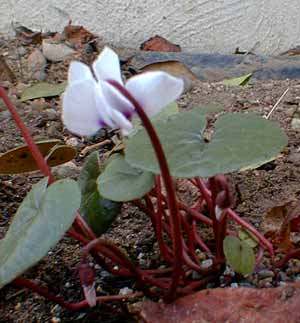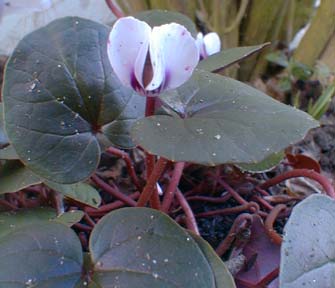 | |
Over the plains where Persian hosts Laid down their lives for glory Flutter the cyclamens, like ghosts That witness to their story. Oh, fair! Oh, white! Oh, pure as snow! On countless graves how sweet they grow! Or crimson, like the cruel wounds From which the life-blood, flowing, Poured out where now on grassy mounds The low, soft winds are blowing: Oh, fair! Oh, red! Like blood of slain; Not even time can cleanse that stain. But when my dear these blossoms holds, All loveliness her dower, All woe & joy the past enfolds In her find fullest flower. Oh, fair! Oh, pure! Oh, white & red! If she but live, what are the dead! "The Cyclamen" | |
White
Winter
Cyclamen
"They are terribly white:
There is snow on the ground,
And a moon on the snow at night;
The sky is cut by the winter light;
Yet I, who have all these things in ken,
Am struck to the heart by the chiselled white
Of this handful of cyclamen."
-Michael Field
(Katherine Bradley, 1846-1914,
& Edith Cooper, 1862-1913)
(Katherine Bradley, 1846-1914,
& Edith Cooper, 1862-1913)
In various catalogs from specialty nurseries, Cyclamen coum ssp coum f. palludum gets listed as 'White,' 'Alba' & 'Album.'
A young plant shown at the top of the page in a February portrait (2004) grows in dry shade underneath our contorted hazel. It did fine in this harsh location but it was not sufficiently visible, so it was eventually moved to a more visible location at the foot of a Western Syringa. Another specimen shown in February (2005) is in a cyclamen patch by our back door, in a spot that is only partly shady in winter, & more water reaches it.
Cyclamens do well in the thick roots of shrubs & trees, up next to root crowns, for they like dryish shade. Even in the wild they are found close to tree trunks.
It is always best to start with seedlings or very young plants when planting that close to an established shrub, as a mature tuber can be a disc of four inches across, & to take a trowel or shovel to dig a hole big enough for that would damage the roots of the shrub. Small starts slip right in between roots & will develop as they require to co-exist happily amidst the roots of the cyclamen's overshadowing protector.
White winter cyclamens have plain unpatterned green leaves. A few have very faint cloudy markings but for ours, the leaf is smooth, round, without patterns.
The underside of these plain leaves are often purple; they never turn their leaves upward, so this isn't much of an added decorative factor, but the stems are also frequently maroon-red & quite appealing.
 The whole flower is often more of an ultra-pale violet or "blue ice" white, almost white rather than true white.
The whole flower is often more of an ultra-pale violet or "blue ice" white, almost white rather than true white.White cyclamens additionally have a plum-violet smudge at the base of each flower, at a point often called "the nose" because that's what England's Ashwood nursery catalog called it & the idea of a plum-colored nose gets repeated as a darned cute notion. Actually most C. coum flowers have either a plum or amethyst-colored nose, but for varieties with pink blooms it doesn't stand out as overtly as on the white.
Whites without the plum nose do exist, notably the specific strain C. coum ssp. coum forma albissimum 'Golan Heights.'
That form was first noted by Manfred Koenen in 1980 in the Amanus Mountains of Southern Turkey, & the cultivated strain called 'Golan Heights' was subsequently collected by the Cyclamen Society during a 1990 expedition to Israel. It's so far quite rare in the trade, so mostly only "plum-nosed" whites are seen. The plum nose is quite visible in the portraits on this page.
All hardy cyclamens naturalize easily, but they rarely grow exactly true to the parent because of intraspecies hybridizing. The plum-nosed 'Album' however, if slightly isolated from other varieties, tends to reproduce true to the parent. As ours is in a bed of mixed cyclamens, I expect intermediate forms will appear after some years.
Continue to
Cyclamen coum, magenta patternleaf